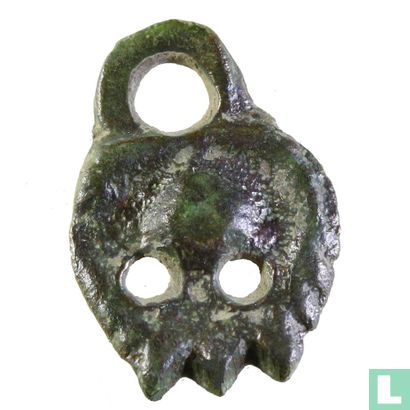Enlarge image
Sicily Medieval lion-head token 1166 - 1189
Catalogue information
LastDodo number
5856721
Area
Tokens / Medals
Title
Sicily Medieval lion-head token 1166 - 1189
Type
Publisher
Value
Country
Year
1170
Collection / set
Material
Weight
Variety / overstrike
Obverse
( head of a lion )
Reverse
Privy mark
Mint mark
Designer
Engraver
Dimensions / Diameter
18x13mm
Number
Details
mass 1.2 gram
William II struck a lion head or scalp on his coins.
William II (1153-1189), posthumously called "the Good", was king of Sicily 1166-1189. Lacking in military enterprise, he seldom emerged from his Palermo palace. Yet his reign was marked by ambitious foreign policy and a vigorous diplomacy. Champion of the papacy and in secret league with the Lombard cities he was able to defy Frederick Barbarossa.
William was only 12 years old at the death of his father William I, when he was placed under the regency of his mother, Margaret of Navarre. Until the king was declared adult in 1171 the government was controlled first by the chancellor Stephen du Perche (1166–1168), cousin of Margaret, and then by Walter Ophamil, archbishop of Palermo, and Matthew of Ajello, the vice-chancellor.
Princess Constance aunt of William was confined in Santissimo Salvatore, Palermo as a nun from childhood due to a prediction that "her marriage would destroy Sicily".
In 1168 du Perche was overthrown by a coup, while the revolts claimed that William was murdered and du Perche planned to have his brother marry Constance to claim the throne.
The death of William's younger brother Henry in 1172 made Constance the only legitimate heir to Sicilian throne (except for a short time in 1181 when William had a living son named Bohemond, but she remained under monastery confinement.
In 1174-1175 William made treaties with Genoa and Venice and his marriage in February 1177 with Joan, daughter of King Henry II of England and Duchess Eleanor of Aquitaine, marks his high position in European politics. This was not his first attempted marriage; an earlier effort by Bertrand II, archbishop of Trani, to negotiate the hand of a Byzantine princess yielded no fruit.
In July 1177, William sent a delegation of Archbishop Romuald of Salerno and Count Roger of Andria to sign the Treaty of Venice with the Emperor. In 1184 William released 30-year-old Constance from convent, engaged her to the Emperor's son, the future Emperor Henry VI to secure the peace, and married her off on January 1186, causing a general oath to be taken to her as his heir presumptive. This step, of great consequence to the Norman realm, was possibly taken that William might devote himself to foreign conquests.
Unable to revive the African dominion, William directed his attack on Ayyubid Egypt, from which Saladin threatened the Latin kingdom of Jerusalem. In July 1174, 30,000 men were landed before Alexandria, but Saladin's arrival forced the Sicilians to re-embark in disorder. A better prospect opened in the confusion in Byzantine affairs which followed the death of Manuel Comnenus (1180), and William took up the old design and feud against the Byzantine Empire. Dyrrhachium was captured (11 June 1185). Afterwards while the army (allegedly 80,000, with 5,000 knights) marched upon Thessalonica, the fleet (200 ships) sailed towards the same target capturing on their way the Ionian islands of Corfu, Cephalonia, Ithaca and Zakynthos. In August Thessalonica fell to the joint attack of the Sicilian fleet and army and was subsequently sacked (7,000 Greeks died).
The troops then marched upon the capital, but the army of the emperor Isaac Angelus defeated the invaders on the banks of the Strymon (7 November 1185). Thessalonica was at once abandoned and in 1189 William made peace with Isaac, abandoning all the conquests. He was now planning to induce the crusading armies of the West to pass through his territories, and seemed about to play a leading part in the Third Crusade. His admiral Margarito, a naval genius equal to George of Antioch, with 60 vessels kept the eastern Mediterranean open for the Franks, and forced the all-victorious Saladin to retire from before Tripoli in the spring of 1188.
In November 1189 William died at Palermo, leaving no children. After his death Norman nobles led by Matthew of Ajello supported Tancred, Count of Lecce, an illegitimate cousin of William, to succeed him, instead of Constance, in order to avoid German rule.

